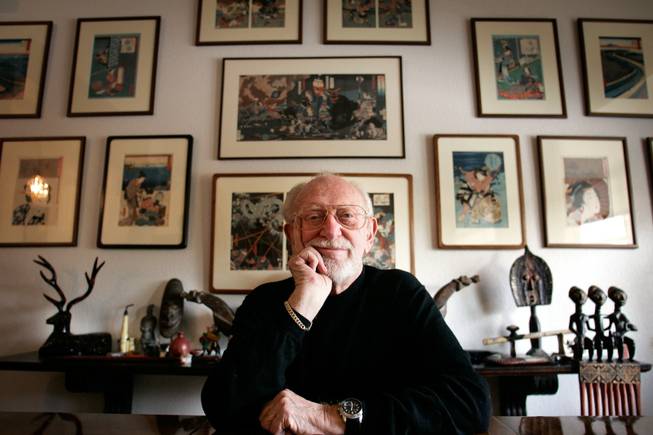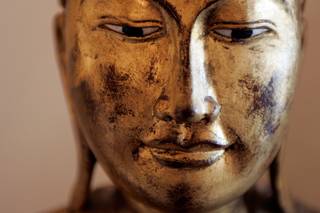
George Cohan, 83, a UNLV lecturer, has traveled to 114 countries. Cohan has collected many objects during his travels, including Japanese woodblock prints that cover the walls of his Henderson home.
Tuesday, Jan. 15, 2008 | 2 a.m.
Audio Clip
- George Cohan on India
-
Audio Clip
- George Cohan on Kilimanjaro
-
To enter George Cohan’s Henderson home is to walk into another world.
A statue of Ganesh, a Hindu deity, greets guests in the living room. Japanese prints on rice paper adorn the walls. On shelves and tables sit curiosities from every end of the Earth a painted ostrich egg, a Chinese cricket cage, a 400-year-old pocket Quran with tiny gold lettering.
Here, every trinket is a treasure. Every souvenir, the subject of a story.
Ask about any of them and Cohan, with a smile, will share with you memories of a journey abroad. Maybe he will tell you about that time he spent 15 days riding across the Sahara on camelback, following Tuareg guides. Or about the time he toured a movie studio on the outskirts of Pyongyang in North Korea.
The son of a globe-trotting mercenary, Cohan inherited his father’s wanderlust. Since World War II carried him overseas for the first time to Burma, China and India, the UNLV lecturer has visited 114 countries on six continents.
“I’m not the type to just look at the museums,” Cohan says. “I’m there to absorb the country, the feel of the place.”
He wants to know what people elsewhere value: “What drives them, what motivates them, what things they consider precious.”
At 83, Cohan embodies the dream of lifelong learning promoted by UNLV’s division of educational outreach, where he teaches.
He lectures on Asia and the Middle East. This week, he will lead a tour group to Vietnam for a private company that connects travelers with academics.
With decades of journeying behind him, Cohan charms his students with the same tales of adventure that have entertained friends and family for years.
An educator and explorer, he is, above all else, a storyteller.
• • •
“My father was a soldier of fortune in his early years, and he traveled the entire world,” Cohan says. “I grew up under a man who had been everywhere.”
As Cohan recounts them, his dad’s voyages seem more the stuff of tall-tale fiction than of reality. His father, Charles, seems larger than life.
At 13, Charles clocked in at 200 pounds, all brawn, all vigor. After scrapping with some goons in 1905 in his home city of Chicago, the boy fled town to elude more trouble.
He went to Cuba.
From the docks of Havana, where he landed, Charles walked 90 miles to a small town where he found work as a general store clerk. After becoming fluent in Spanish, he returned to the capital to serve as an interpreter.
But, always a fighter, the teen got into another bind before long, this time tossing a policeman into the bay. Again on the run, he stowed away on a Greek freighter bound for South Africa. After the ship was too far out to sea to turn back, he emerged from his hiding spot. The captain put him to work.
Before returning home in 1915, Charles sailed around the world, taking up arms in places from Asia to South America.
Though the two became close friends later in life, Cohan and his dad rarely spoke to each other when Cohan was a boy.
“I was a puny little runt that he was ashamed of, really,” Cohan says.
Still, his mother’s accounts of his father’s travels stoked Cohan’s curiosity about the world. So as a man, he embarked on an odyssey of his own. The journey never ended.
• • •
World War II rages in the Pacific. Cohan, a demolitions specialist in the Army Corps of Engineers, is walking through the jungles of Burma. Tired, he sits down on a log.
The log starts moving.
Looking down, Cohan realizes the log is not a log at all, but a 15-foot python. He leaps up, screaming, and runs for half a mile, his heart pounding.
That story is one of many favorites Cohan’s daughter Vicki Bloom remembers from her childhood.
Bloom, 47, says when she was younger “I traveled through my father’s eyes since I wasn’t really able to do it.”
“My father is one of the world’s greatest storytellers,” says Gail Cohan, 58, another daughter. “He’s animated. He’s just delightful to watch.”
George Cohan’s accounts of his journeys abroad, vivid and thrilling, emboldened his children to travel as soon as they had time and money.
A retired advertising executive, he has six kids. His first wife died of cancer. His second, who suffers from Alzheimer’s, stays at an assisted-living facility in Southern California.
He lives alone with a cat. But in his students he has found another audience eager to hear about his overseas jaunts.
He sprinkles his talks with anecdotes about people he encounters abroad guides or drivers, fellow customers at a cafe, says Terrie Bernard, 76, a longtime student going on this week’s Vietnam trip.
An actor who has performed with theater groups, Cohan brings his stage skills to the classroom. His voice is powerful, his tone expressive, Bernard says: “He mesmerizes.”
And when it comes to lifelong education, Cohan is not only a teacher but a scholar, too. He spends about a third of the year traveling, learning about other cultures, other ways of living.
“He has this lust for life that is just inspiring,” Gail Cohan says.
Her father, she says, is proof that a person can grow old without feeling old. That even in life’s winter, discovery can continue.
And George Cohan’s adventures, his spirit, will survive long after he is gone. They will live on in his loved ones’ memories, through his stories.
• • •
A light rain falls outside. An orange cat sleeps on the table. Lamplight illuminates Japanese woodblock prints hanging on the walls of George Cohan’s living room. And the octogenarian, with a sparkle in his eyes, leans back in his chair.
He is ready to tell his story.
As you listen, you suddenly find yourself beside him, walking down the streets of Tripoli, riding a bullet train in Japan. You are boating off the shores of Vietnam, building an air base in the Arctic.
You are 80 and learning Arabic, 50 and resolving not to die with unfulfilled wishes, 20 and wide-eyed, crossing an ocean.
The magic of a story lies in its power to transport a person to another place, another time. History rises from ruins. Metropolises thousands of miles away come to life.
It is night now, and you are in Henderson.
But with Cohan playing host, you are also in Libya, in Syria, in Iran.
You are catching your breath atop Mount Kilimanjaro. You are standing on a deserted boulevard in Pyongyang, in awe of the silence. There is not a car in sight. You are squatting in an alley in Tamanrasset, Algeria, alone with a stranger who has just pulled out a 10-inch-long knife. You are wondering what will happen next.


Join the Discussion:
Check this out for a full explanation of our conversion to the LiveFyre commenting system and instructions on how to sign up for an account.
Full comments policy